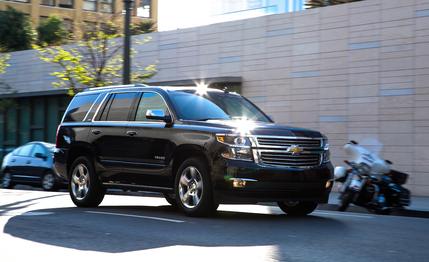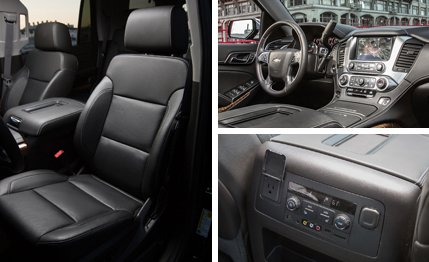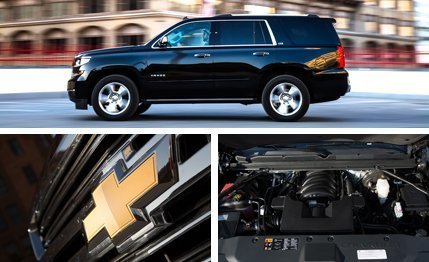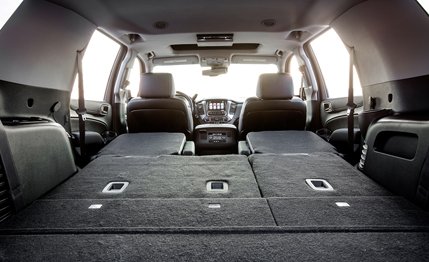 Instrumented Test
Instrumented Test
“It’s a bit like driving a shipping container,” said our U.K.-based passenger. He didn’t mean it as a compliment. If you’d never driven a Chevy Tahoe, you, too, might be shocked by its gargantuan size and 5756 pounds. Shipping containers are spacious and useful, though, and so is the new Tahoe.
Much of this SUV’s appeal stems from its politically incorrect size. It’s a Big Mac in a world going vegan. Big on this scale means you don’t have to bother organizing your dog kennels, antique firearms, and stuffed elephants; just throw everything in back, it’ll all fit. Don’t like who’s riding shotgun? No worries. A console as big as a coffee table keeps the driver and front passenger from violating any restraining orders. And there’s even more than an inch-and-a-half additional front-seat headroom versus the previous model, too, so leave on that Stetson, Tex.
All that bigness is born of the Tahoe’s full-size pickup origins. Chevy introduced a redesigned Silverado last year, and the Tahoe inherits the many structural enhancements that Chevy bestowed upon its reborn pickup. New body and boxed-frame designs improve structural rigidity, and a higher percentage of high-strength steel helps keep the weight in check.
 So ritzy is the Tahoe's new interior, particularly in LTZ guise, that Chevrolet claims that your baby sitter will demand a raise.
So ritzy is the Tahoe's new interior, particularly in LTZ guise, that Chevrolet claims that your baby sitter will demand a raise.
Despite these claims, quivers still ripple through the structure. Bolted to the frame is an independent front suspension, while a live rear axle with coil springs benefits from the Silverado’s slightly wider track. Unlike the Silverado, though, the Tahoe offers constantly adjusting magnetorheological shocks. Now in its third generation, Magnetic Ride Control is standard on and exclusive to the top-level LTZ trim. These dampers help round off bumps and keep the body from bobbing excessively. But on choppy freeways and with 20-inch wheels, the Tahoe jitters as if it’s had one too many shots of espresso.
Electrically assisted steering, chosen for its simplicity and fuel-economy benefit, is also new. Light steering helps make the Tahoe wieldier than its prodigious shadow might suggest, and the 39-foot turning circle shows it to be more maneuverable than you’d expect. But don’t get the idea that the Tahoe is in any way city friendly, unless, of course, it’s wearing police- or fire-department livery.
Another Silverado hand-me-down is the 5.3-liter V-8. Now equipped with direct fuel injection, variable valve timing, and cylinder deactivation, and featuring an aluminum block, this small-block V-8 makes 355 horsepower and 383 pound-feet of torque. It channels this output through a six-speed automatic with manual override and a towing mode that holds gears longer, downshifts sooner, and could be labeled “sport” if it were in something sportier than the Tahoe.

Acceleration to 60 mph takes 7.1 seconds, and the quarter passes in 15.6 at 91 mph. That’s plenty of poke to easily merge onto a freeway. Tahoe buyers who like to haul will probably gloss over our acceleration figures, wanting to know the Tahoe’s towing capacities. Four-wheel-drive versions can hitch up to 8400 pounds; two-wheel drive, 8600 pounds. What those looking to tow shouldn’t ignore are the Tahoe’s strong, fade-free brakes. Stops from 70 mph took 176 feet, a number that would be respectable for a family sedan. Fuel economy comes in at 16 mpg city and 22 highway for a four-wheel-drive edition like the one here; we recorded 15 mpg over 329 miles of driving.
For the first time in the Tahoe’s history, the front doors aren’t shared with the Silverado. This allowed designers to create a distinctive look for the ute, with abundant right angles in the greenhouse bestowing a sharp, expensive look. Running from the front fender to the taillights is a bone-line crease that adds visual crispness and length. This latest Tahoe appears more elegant than its predecessor, which is important because our Tahoe LTZ’s price sailed right past $70,000.
Opening those front doors reveals a redesigned interior. A tall center console borrows some of the Silverado’s switchgear and easy-to-read analog instruments, but the Tahoe earns its own design. A 4.2-inch digital display between the gauges can show speed, trip-computer, or infotainment data, and it can be used to adjust settings. A vinyl-wrapped instrument panel looks rich, but the wood trim is bogus. If you want real wood, you’ll have to shop at the GMC store. At a steady 70 mph, we measured a luxury-car-like 68 decibels of noise, though a bit of wind rush can be heard rustling past the A-pillars, which punctures the illusion of blissful isolation from the outside world.
 When folded, the second- and third-row seats create a flat load floor. But, thanks to the live rear axle, it's a high and flat load floor.
When folded, the second- and third-row seats create a flat load floor. But, thanks to the live rear axle, it's a high and flat load floor.
Chevy didn’t alter the Tahoe’s 116-inch wheelbase, so second-row legroom is unchanged from the previous generation. But by moving the B-pillars forward, Chevy was able to make the rear doors longer, which makes getting in and out of the Tahoe’s back seat easier.
Way back in third-row county, not much has changed, either. As in the last Tahoe, the floor is high to make space for the live axle at the expense of your legs. That third-row bench has a fixed seatback angle that will have adults squirming after a few miles. Our LTZ example did come with a power auto-folding third row and flip-and-fold second-row captain’s chairs. Fold away those rows and the Tahoe will take 95 cubic feet of your hoard. But getting all that stuff inside will require lifting it above a high (and newly flat) cargo floor, which accommodates the full-size spare tire carried underneath.
Tahoe prices begin at $45,595 for a rear-drive Tahoe LS, $50,995 for a mid-level LT, and $59,995 for the top-shelf LTZ. Adding four-wheel drive to any trim level costs $3000. The new Tahoe’s appeal might have eluded our passenger, but to Americans who revere live axles, small-block V-8s, full-length frames, and enough space for the entire family, this SUV makes a lot of old-fashioned sense. And, should you need even more space, Chevy can sell you an even bigger shipping container. It’s called the Suburban.